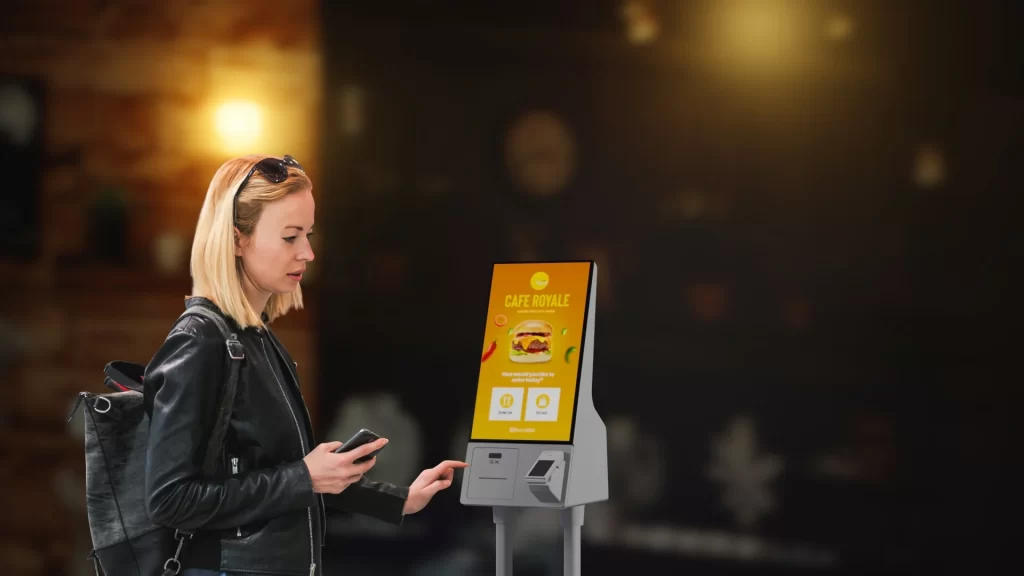Are you a restaurant owner trying to decide if a self-ordering kiosk is right for your establishment? Or have you already decided to move forward with your purchase but you’re unsure of how to maximize the benefits of your new machine?
Restaurant kiosks, like self-checkout lanes in grocery stores, provide your customers with an alternative ordering experience as opposed to in-person, online, and over the phone. For those restaurant operators still unsure if a kiosk is right for them, let’s first discuss some of the high-level advantages and disadvantages of investing in a restaurant kiosk.
Deciding Whether or Not to Get a Restaurant Kiosk
Making the initial decision to get a restaurant kiosk may be the hardest part of the process. On one hand, you are offering a convenient ordering experience to your customer base. On the other hand, you are investing a significant amount of money into the kiosk purchase (including ongoing fees and maintenance), while possibly impacting the experience and ambiance within your restaurant.
Advantages of Restaurant Self-Ordering Kiosks

By implementing a self ordering kiosk for your restaurant, you are creating a safe space for your customers to privately place their orders. They don’t risk being judged by the cashier or other customers in the restaurant for placing high-caloric or heavily modified orders. This can subtly, yet substantially improve the ordering experience. A quick list of some of the other benefits that kiosks provide :
- Customers have greater control over their orders from end to end.
- Faster overall order experience with decreased wait times.
- Cross-sells and upsells can automatically be presented to customers while ordering.
- Less restaurant overhead due to needing fewer cashiers.
- Must Read: Self-ordering Kiosks help combat the Labor Shortages in the restaurant industry
Disadvantages of Restaurant Self-Ordering Kiosks
Self-ordering kiosks work best in fast food and fast-casual restaurants. If you have a sit-down restaurant or diner, a kiosk may not prove to be effective for your clientele. Beyond this industry limitation, here are a few of the other drawbacks you might encounter with implementing a kiosk :
- Kiosks reduce human interaction, which can negatively impact the in-store experience.
- Kiosks ultimately outsource jobs to machines, which reduces the number of employment opportunities in your local area.
- Kiosks must be maintained regularly to ensure they function properly. This means regular maintenance for ad hoc technical issues. It also includes paying potentially steep recurring fees to access premium features and software updates.
- Self-ordering kiosks are expensive – a top-of-the-line kiosk could run your business as much as $4,000+ for just the initial investment.
How to Successfully Implement Restaurant Kiosks in Your Store?
1. Laying the Foundation: Understanding the Need for a Self Ordering Kiosk
Before delving into the implementation, it’s crucial to recognize the value a Self Ordering Kiosk brings to your restaurant. In an era where convenience and speed are paramount, a Self Ordering Kiosk meets your customers’ expectations, offering a swift, seamless, and personalized ordering experience. This not only elevates customer satisfaction but also streamlines your operations, allowing your staff to focus on delivering exceptional service rather than managing order queues.
2. Evaluating the Benefits: Why a Self Ordering Kiosk is a Game-Changer
Integrating a Self Ordering Kiosk system brings multifaceted benefits:
- Enhanced Customer Experience: Customers relish the autonomy and accuracy of self-ordering, leading to increased satisfaction.
- Operational Efficiency: Direct kitchen order transmission reduces wait times and enhances the overall flow of service.
- Financial Upside: Experience potential growth in average order value due to effective upselling and cross-selling through the kiosk.
- Reduced Labor Costs: Allocate your resources more effectively by reducing the need for front-of-house staff to take orders.
Must Read: The Rise of Self Ordering Technology in US Culture
3. Crunching the Numbers: Understanding the Investment
The journey begins with understanding the investment required. While the initial costs for hardware, software, and installation may seem daunting, it’s vital to consider the long-term benefits and cost savings. Analyze factors such as the potential increase in order value, customer turnover rate, and labor cost savings to paint a clear picture of the return on investment (ROI) a Self Ordering Kiosk can offer.
4. Selecting the Perfect Fit: Choosing the Right Kiosk System
Selecting the right Self Ordering Kiosk system is paramount. Consider factors such as:
- User Interface: Opt for a system with an intuitive, user-friendly interface.
- Integration Capabilities: Ensure the system integrates smoothly with your existing POS and kitchen management systems.
- Customization Options: Look for systems that offer customization to reflect your brand and menu.
- Reliability and Support: Choose a provider known for reliable hardware and responsive customer support.
5. The Implementation Roadmap: Step-by-Step Guide

Implementing a Self Ordering Kiosk involves strategic planning:
- Infrastructure Assessment: Evaluate your space and infrastructure to determine the optimal placement and number of kiosks.
- Staff Engagement and Training: Involve your staff early in the process, offering comprehensive training to ensure they are confident in assisting customers and managing the new system.
- Customer Onboarding: Educate your customers about the kiosk, highlighting its benefits and ease of use to encourage adoption.
- Feedback and Iteration: Once implemented, actively seek customer and staff feedback to make necessary adjustments and enhance the kiosk experience.
Must Read: Powerful Features on a Self-Ordering Kiosk to Increase Customer Average Ticket-Size
6. Marketing Your New Kiosk:
Introduce your new kiosk to customers with strategic marketing:
- In-Store Promotion: Utilize signage and staff to promote kiosk usage.
- Digital Marketing: Leverage your online presence to inform and excite your customer base about the new ordering option.
- Incentivization: Consider offering initial discounts or loyalty points for orders placed through the kiosk to encourage trial and adoption.
7. Overcoming Challenges: Ensuring a Smooth Transition
Address potential challenges head-on:
- Technical Support: Establish a reliable support system to address any technical issues promptly.
- Customer Resistance: Some customers may initially resist change. Patiently guide them through the new system, highlighting its benefits to win them over.
- Continuous Improvement: Treat the implementation as an ongoing process, continually seeking ways to enhance functionality and user experience based on feedback.
Must Read: The 9 Reasons Your Restaurant Needs a Self-ordering Kiosk
Conclusion
Integrating a Self Ordering Kiosk into your restaurant is a strategic move that aligns with modern dining expectations and operational efficiency. It’s an investment in your brand’s future, promising enhanced customer satisfaction, operational excellence, and financial growth. By understanding the benefits, choosing the right system, and executing a thoughtful implementation plan, you can ensure that your restaurant remains at the forefront of the industry, offering an unmatched dining experience that keeps patrons coming back for more. Welcome to the future of dining, where technology meets taste, and every order is an opportunity to impress.












Leave a Reply